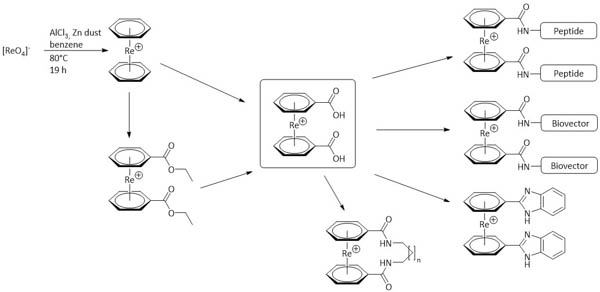Synthesis and Derivatisations of [Re(η6-C6H5COOH)2]+
Functionalised bis-arene complexes of transition metals are used as precursors for numerous reactions with applications in different fields, including medicinal inorganic chemistry and bioorganometallic chemistry.[1-4] Recently, functionalised [M(η6-arenes)2]n+ sandwich complexes, containing the d6-{Ru}2+ and {Os}2+ cores attracted attention as potential anti-cancer agents.[1,5] The introduction of functionalities in d6-metal bis-arene complexes with chromium and molybdenum has also been described but studies with those complexes are comparably rare in bioorganometallic chemistry. Studies with group 7 bis-arene compounds (Re and Tc) are very rare in any respect, although their syntheses were already described in the 1960s.[1]
Searching for new organometallic building blocks for imaging (99mTc) and therapy (Re) in the context of theranostics, our group introduced a new synthetic route for the synthesis of the precursor complex [Re(η6-C6H6)2]+ directly from [ReO4]-.[1,6]

This work focuses on an improved synthetic pathway to [Re(η6-C6H5COOH)2]+. Beside the high chemical stability of these complexes and its inertness towards oxidation and hydrolysis, the carboxylic groups represent a core feature for derivatisations with targeting moieties via amid bond formation. Amino acids, peptides or other biomolecules can conveniently be introduced along this approach.
[1] G. Meola, H. Braband, P. Schmutz, M. Benz, B. Spingler, R. Alberto, Inorg. Chem., 2016, 55, 11131-11139 [2] M. Benz, H. Braband, P. Schmutz, J. Halter, R. Alberto, Chem. Sci., 2015, 6, 165-169 [3] E.A. Trifonova, D.S. Perekalin, K.A. Lyssenko, A.R. Kudinov, J. Organomet. Chem., 2013, 727, 60-63 [4] G. Pampaloni, Coord. Chem. Rev., 2010, 254, 402-419 [5] D.S. Perekalin, A.P. Molotkov, Y.V. Nelyubina, N.Y. Anisimova, A.R. Kudinov, Inorganica Chimica Acta., 2014, 409, 390-393 [6] G. Meola, H. Braband, D. Hernández-Valdés, C. Gotzmann, T. Fox, B. Spingler, R. Alberto, Inorg. Chem., 2017, accepted